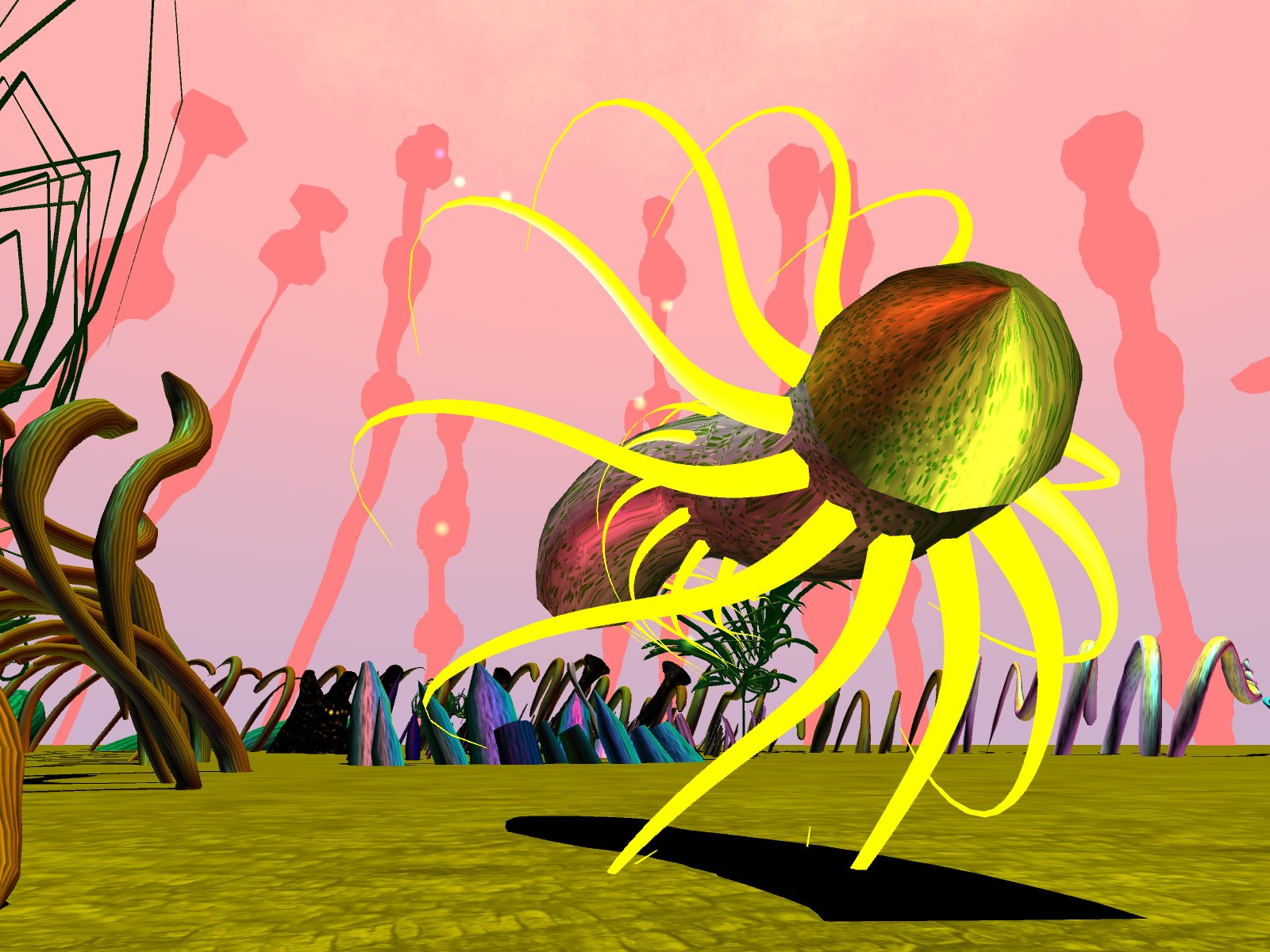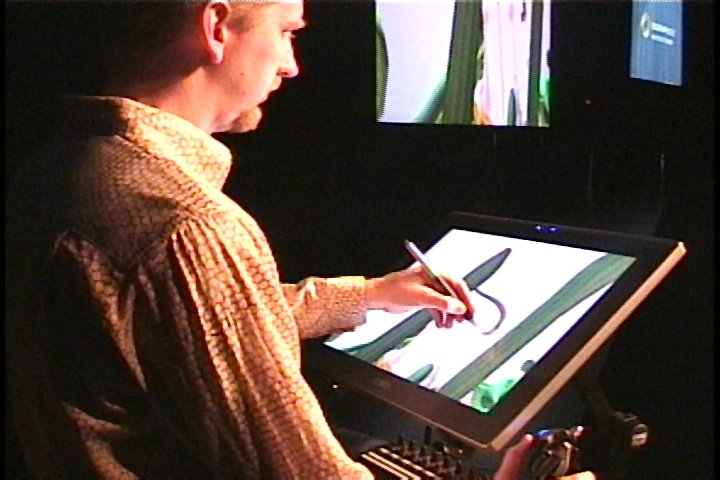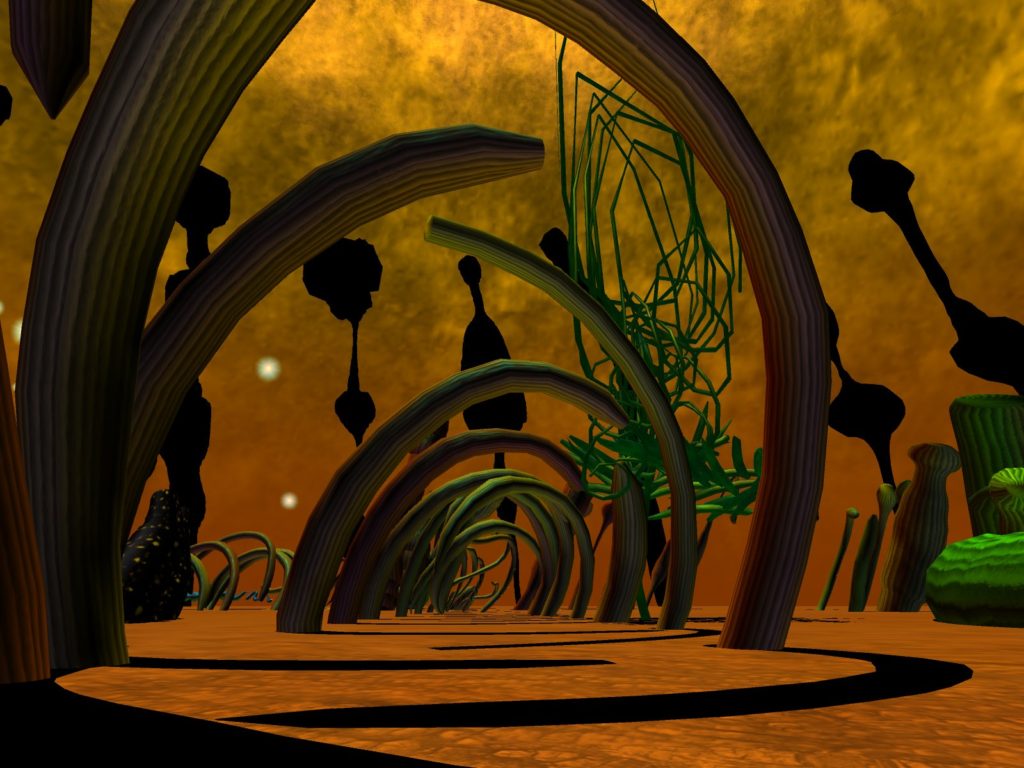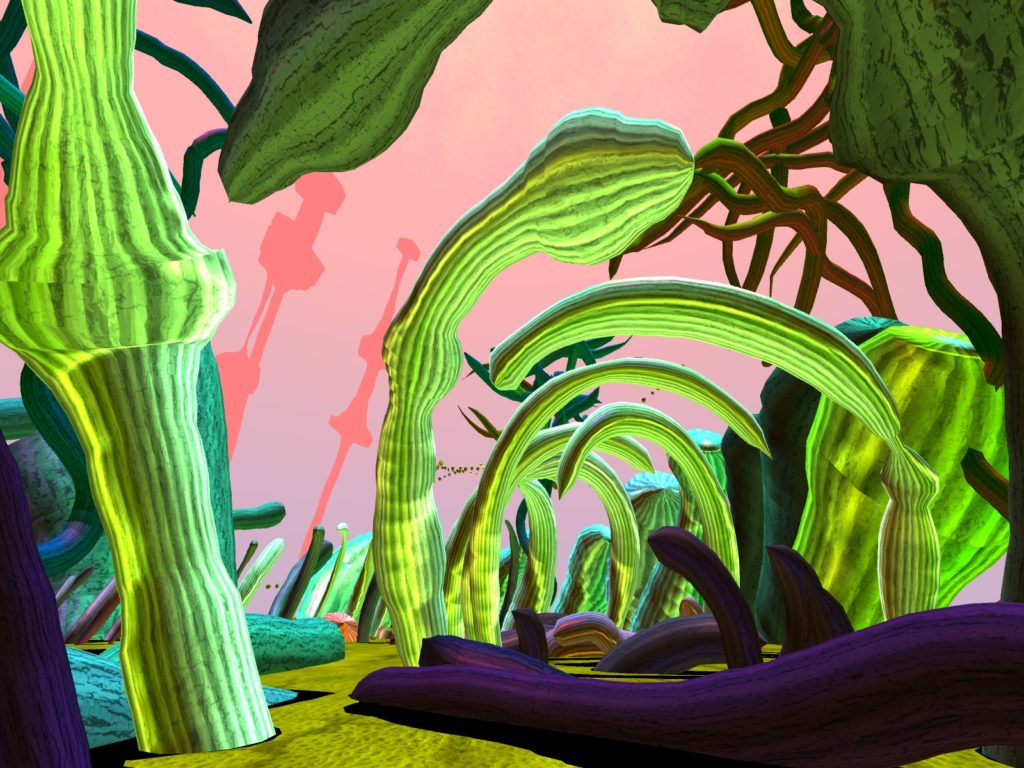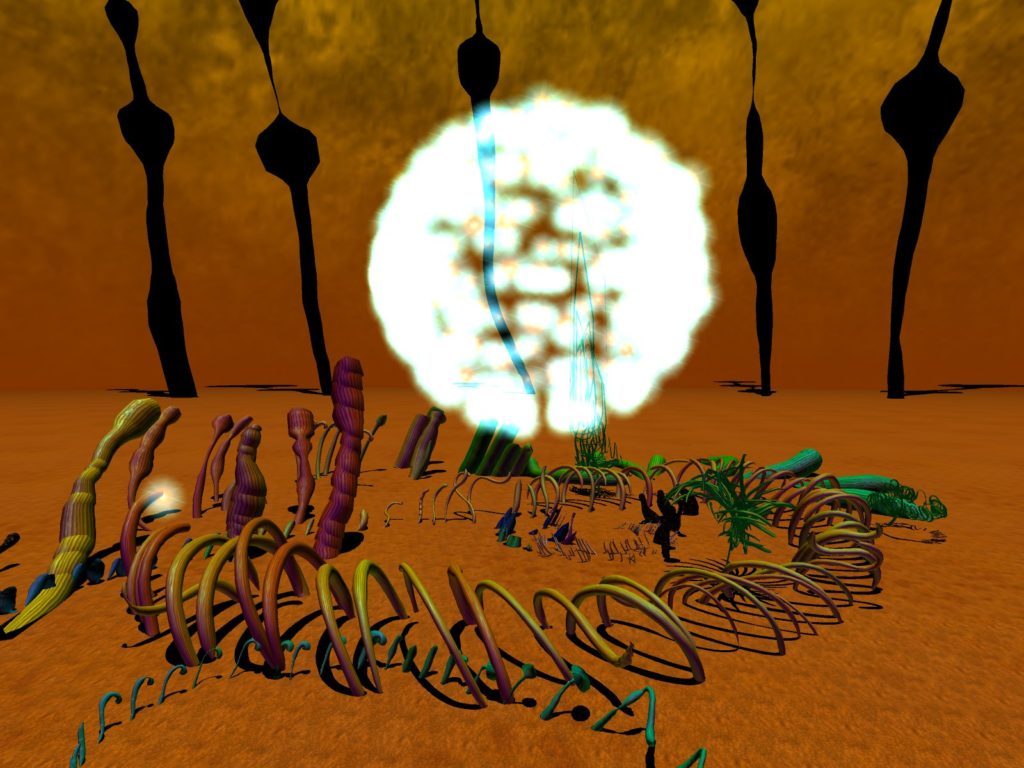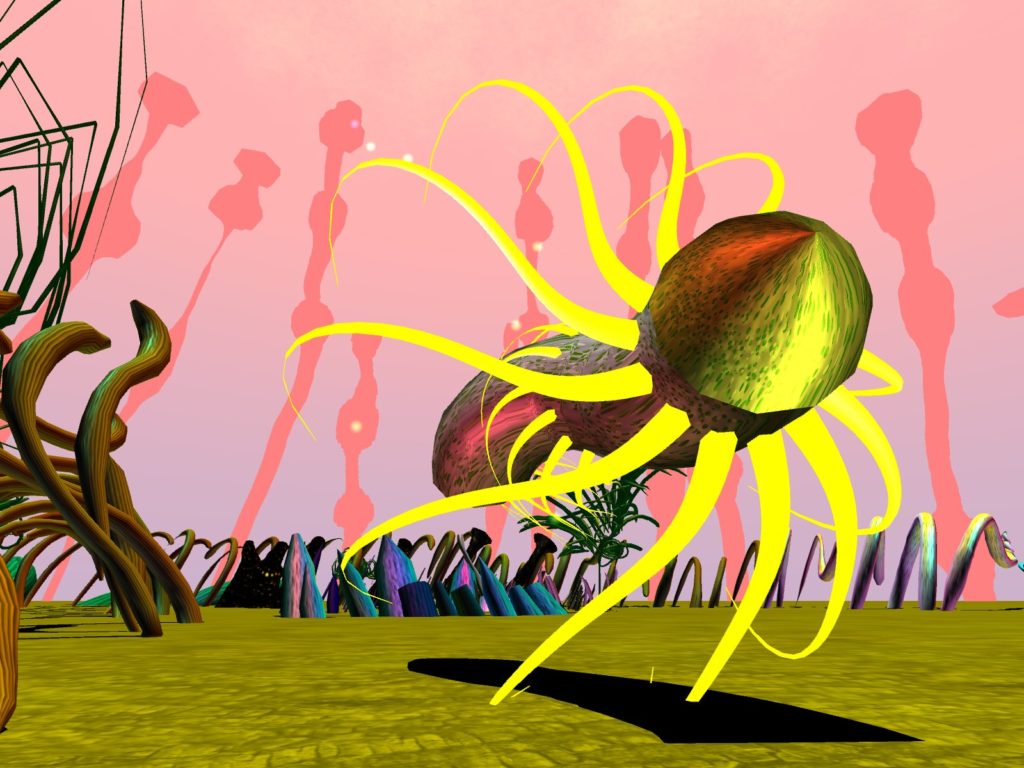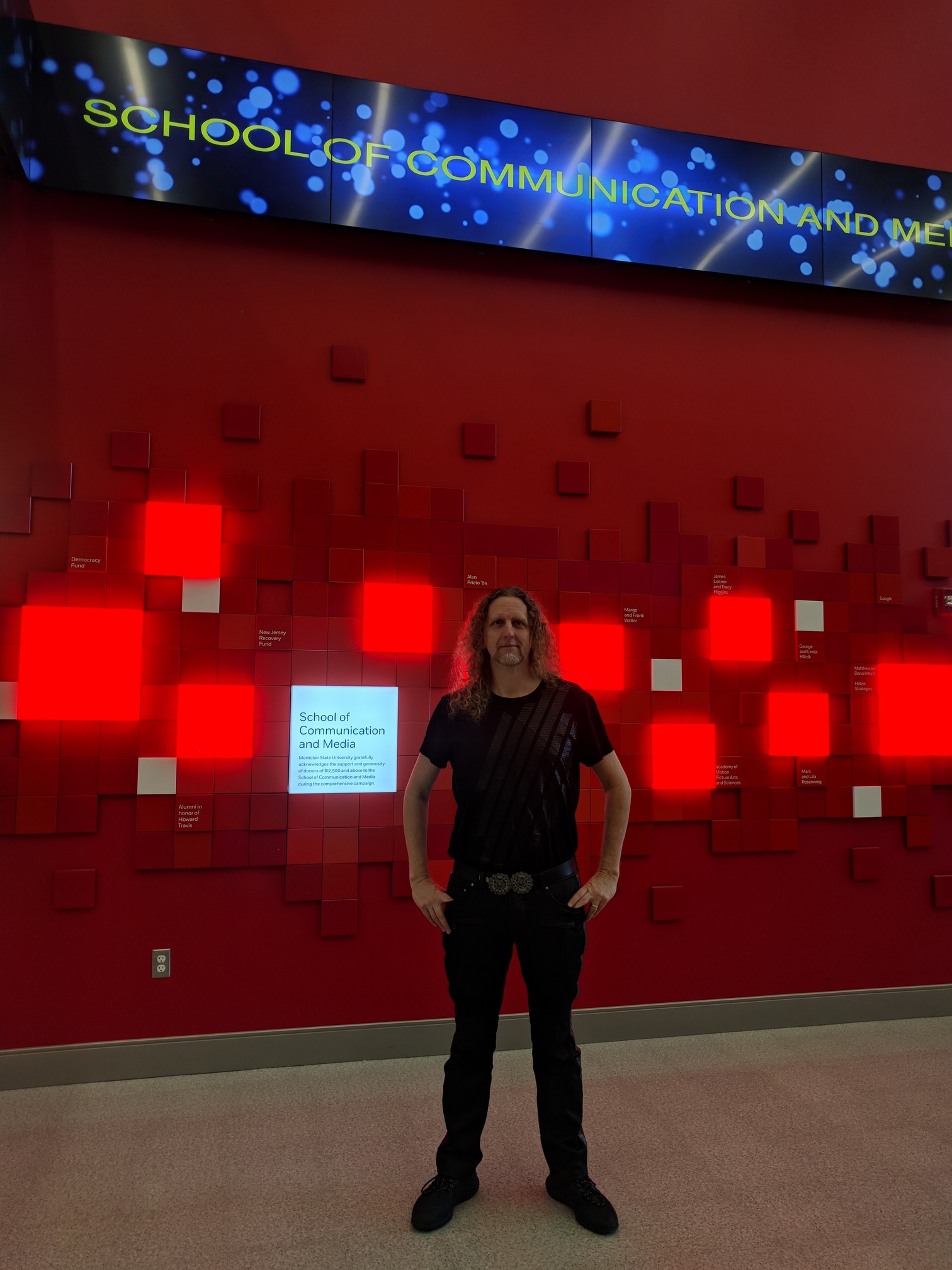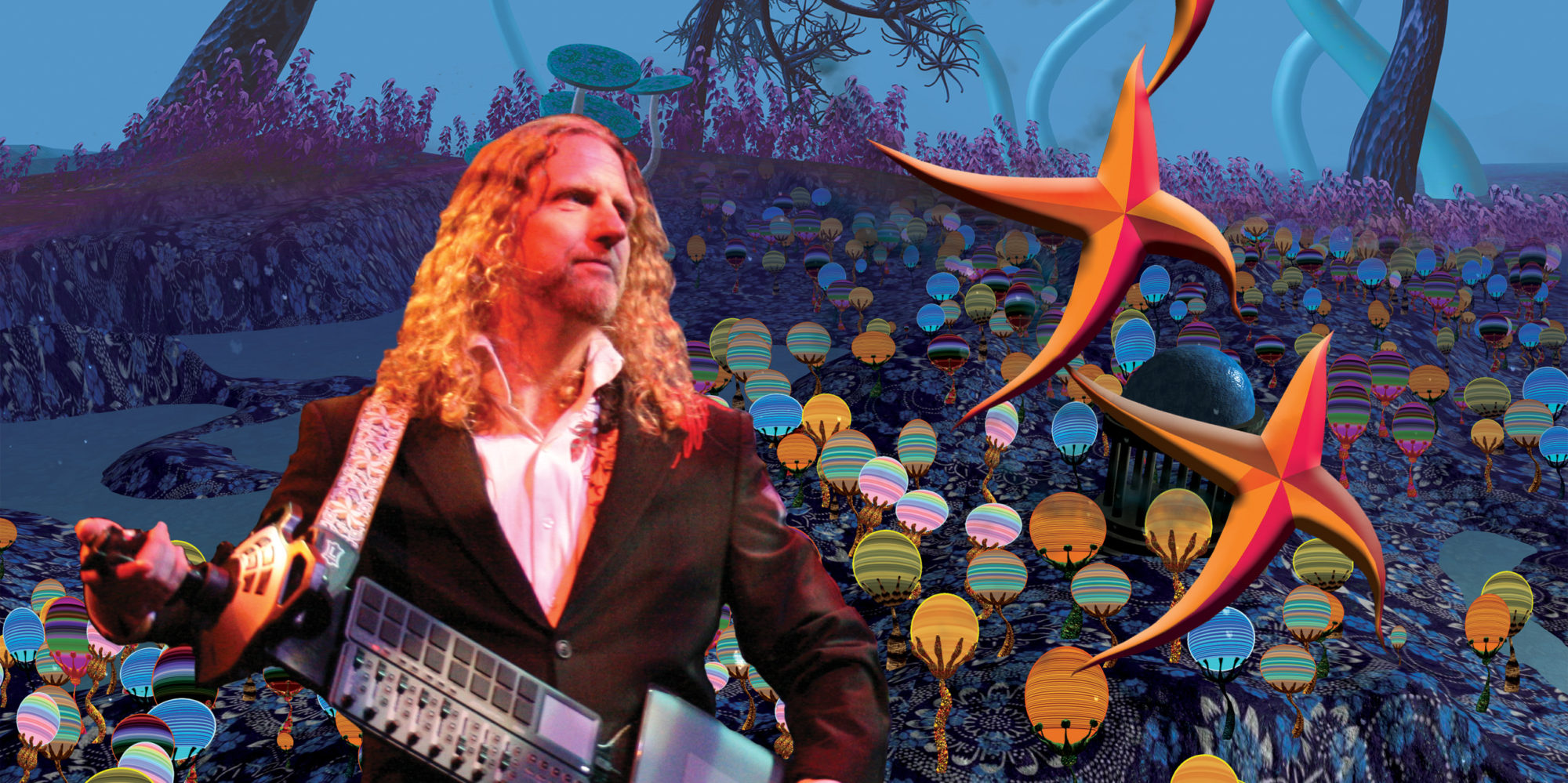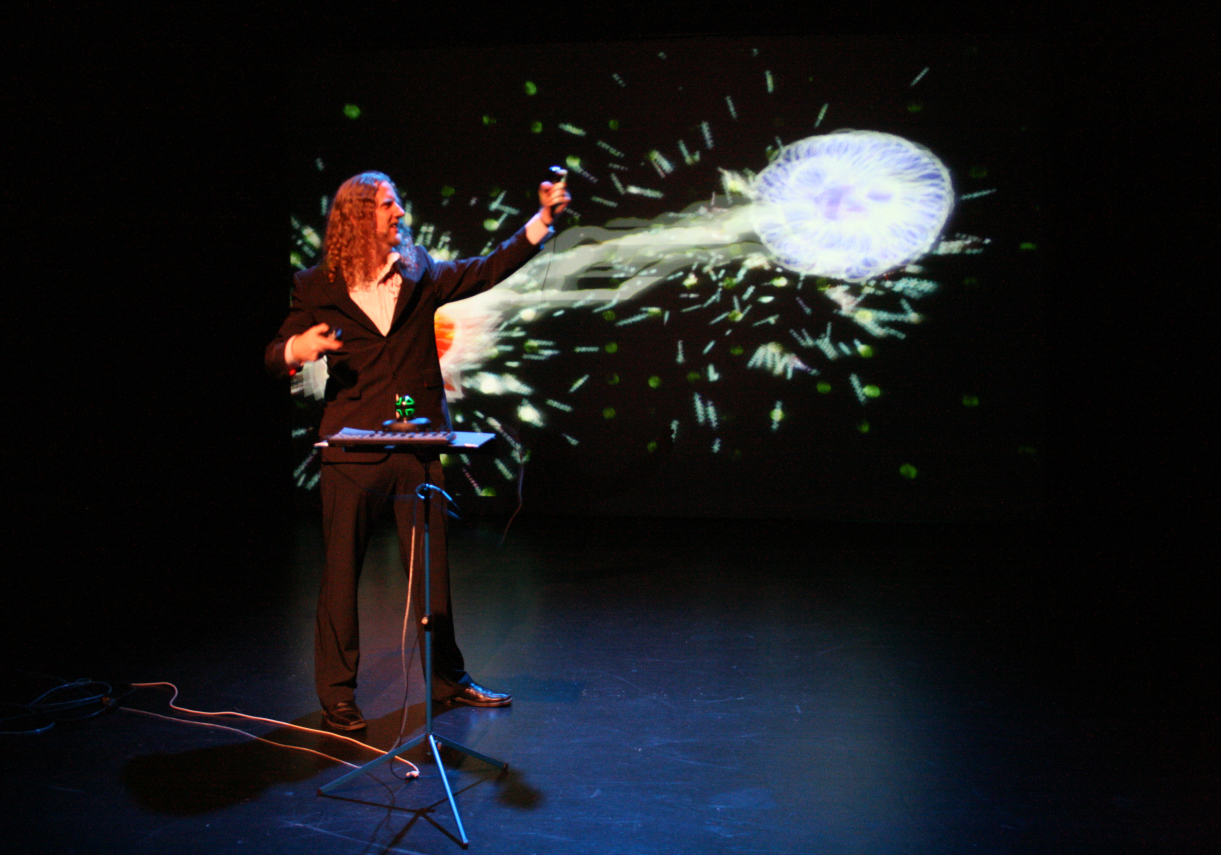In August, 2005, I performed a new work: “Autocosm: Gardens of Thuban”. I consider this one of my breakthrough artworks. I had been developing and presenting my graphic performances for a couple of years prior to this event, and this was a quantum leap for me, technically and creatively.
I premiered this piece for the annual SIGGRAPH convention, which was at the Los Angeles Convention Center that year. My performance was the preshow to the Electronic Theater, the big movie event that SIGGRAPH holds. I performed the work five times over three days, each time for a crowd of about 2000. Each performance went flawlessly, even though I was nervous and was afraid my software would crash at any moment.
“Autocosm: Gardens of Thuban” was an step in creating a system that allowed me to create worlds in a freeform way. Nobody had done this before with 3D computer graphics. There were plenty of examples of people presenting live graphics in which the artist manipulates and tweaks pre-built models and effects. That’s still the dominant way that people perform graphics. I was doing something deeper. I was creating a world that persisted for the duration.
My mode of performance is a combination of drawing, sculpting, and puppetry. The actions and gestures become the space and the objects. I don’t think there are precedents for how I combined these actions. I was also among the first to use a pressure-sensitive tablet in computer performances, at a time when most people were using awkward but readily-available interfaces — typically a mouse and QWERTY keyboard, and occasionally a MIDI controller. For this SIGGRAPH performance, Wacom loaned me one of their new Cintiq displays, so they became a sponsor for my presentation, along with NVIDIA, who loaned me a new graphics card.
There are two parallel stories in “Thuban”. One story is the growth of a garden on a planet: As the sun rises, plants sprout and grow from the ground, spontaneously populating an area which becomes a garden. A dragon-like creature burst forth from a pollen embryo and fertilizes the plants, turning their surfaces bright and shiny. The faceless dragon dances through the garden in a celebration of life and energy.
The second story is experienced when you watch me perform: The artist J-Walt draws and sculpts organic gestural forms with his electronic pen. He transforms an empty plain into a sculpture garden. He steps from simple designs to more complicated designs. Then he begins to draw with augmented strokes that wave and pulse. J-Walt completes the landscape by drawing strokes which transform into mountains, and then builds up to a climax. As J-Walt moves into the middle of the garden, he explodes the scene with color and rhythm. The ambient music gives way to an exotic beat. J-Walt puppets a chrome dragon around the scene, revisiting and transforming each of his sculptures before ending the pieces with a booming drum.
These two stories differ in perspective. One can see this as a natural chain of events, or as an intentional series of choices. Or, it’s both of these simultaneously. The difference in point-of-view between these stories is the difference between being a passive observer and an active motivated participant. This is a metaphor for other contexts in our lives and how we shape the future (but I won’t get into that now!)
I had wanted to perform at SIGGRAPH partly because I wanted exposure, but mostly to publicly document the work I was doing — to put a timestamp on it. I’d been to SIGGRAPH enough to know that art takes a back seat to technical accomplishment. The community is very techie, and the people who appreciate art have been on the fringe. I had asked my friends Henry Kao, Audri Philips, and Kino Gil to record video of my performances. Looking back at the audience reactions, I could see that my predictions were correct. About half the people were engaged with my art, while the other half were just waiting for the main event to begin. They were just waiting for cartoons, which is what most of what the Electronic Theater was.
Some understood that I was presenting something new, but it went over the heads of most of the crowd. The SIGGRAPH crowd at that time didn’t value real-time graphics. 2005 wasn’t a big year for 3D stereoscopic demonstrations, either. None of the big studios had requested a stereoscopic system, so I couldn’t show in 3D. And while VR was in its nadir in 2005, I was presenting Virtual Reality. I call this a VR performance. Certainly there is no headset, but headsets are not required for VR. I was painting in 3D as I flew through the space. I was creating virtual worlds from the tip of my pen. I was treating reality as a fluid continuum of ephemeral space, form, time, and movement. I had invented a free-flowing interface and was presenting it in the context of a fully-realized art form. People only now are discovering this freedom with newer 3D painting tools such as Tilt Brush and Medium. Back then, they didn’t get it. They just wanted their cartoons.
Some people did understand and appreciate what I was doing, and I am thankful for that. The few who saw more than one of my performances were amazed to see that I was doing something markedly different in each show. Even though I had told them I had the freedom to do switch things up, this was a new experience for them. Animation and visual effects is dominated by scripted teleplays and carefully plotted frame-by-frame sequences. With each of my performances of particular piece, I have a particular overall structure in mind, but I also have the freedom to move, draw, and explore in fresh ways each time. Seeing me do this was — and continues to be — a revelation for many people. My presentation of variations gives them a deeper understanding of how and why I am performing this way. There is a richness of creation that can’t be matched any other way.
Sadly, a lot of the veteran SIGGRAPH crowd — the “cool” people — didn’t see my performances. The Electronic Theater had once been the annual Grand Event of CGI, but at that point, the event had lost its must-see status. Worse, the conference organizers were charging $50 per ticket to see the movie show. That’s a steep price even today, tacked on to an already over-priced conference. The entry fee dissuaded a lot of long-time SIGGRAPH attendees, including many of my colleagues.
One of my technical achievements for that show is hard to explain, even though it’s easy to state. My presentation was a one-man show, and it was the only one. All the movies they would show — all the tech demos, cartoons, FX breakdowns, etc. — had many people working on each of them. Some of the work had a hundred or more people involved. I did this show all myself: all the music, all the graphics, all the software. That’s an important achievement (and not just for my ego!) This point addresses how we use computers, how we design for artistic expression and how users are empowered (or not).
It’s hard to brag about this point, because most people don’t understand how art is made. They don’t think about the process. Even when people see the thousands of names scrolled after a movie, they only think of the director and the star actors as being involved. I like to stress that we don’t need factories of technicians to make art. We don’t need to have a division between technical and creative work. It’s a false dichotomy. But that division is entrenched in movie production, where you’re expected to be an artist or an engineer, and not both. I try to make the point that there’s a model for creative work that engages all of it. And especially with computers, we can build technologies that encourage individual expression. I would think that this is something that is important to an ACM conference, but somehow I’ve never seen this point come up.
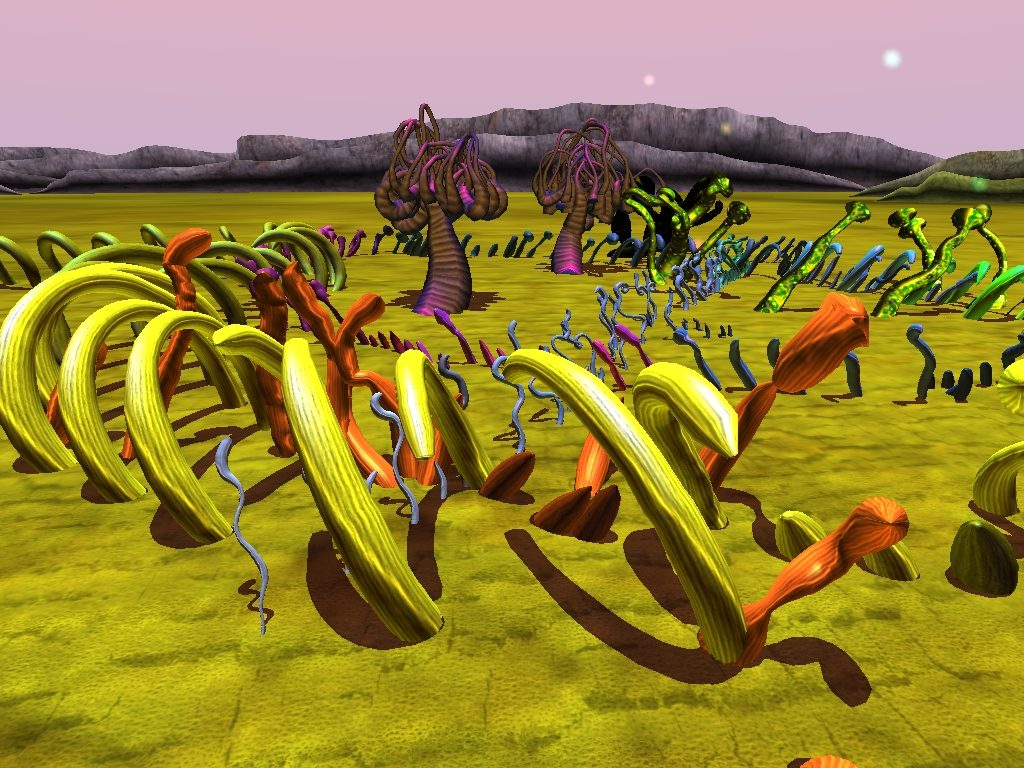 I’m proud of what I accomplished with “Thuban”. I could have shown a technical demo of my “instrument”, and maybe that would have gone over better with that crowd. But that’s not why I do it. I have no interest in engineering for engineering sake; I want to make art!
I’m proud of what I accomplished with “Thuban”. I could have shown a technical demo of my “instrument”, and maybe that would have gone over better with that crowd. But that’s not why I do it. I have no interest in engineering for engineering sake; I want to make art!
I would go on to perform “Thuban” perhaps a hundred times or more, mostly in planetarium domes, in which I started to perform in 2007. Each performance allowed me the opportunity to discover something new in that world — to extend sections or tighten them up, to craft inventive configurations of stalks, or to improve my gestural techniques. Sometimes I would perform in 3D stereoscopic, and sometimes in a 3D dome. I might have also changed the music a little bit to clean up something or change the timing of a section, but I think it remains true to the first performances.
The concept for “Autocosm: Gardens of Thuban” is deeply rooted in science fiction literature and illustration. I consider that I am presenting a documentary of an alien ecology that possibly exists somewhere, or which may exist in the future. There aren’t many stories that detail the biome of an alien world. Greg Bear’s “Legacy” is one novel that does, and his example was an inspiration.
The word “Thuban” comes from the Arabic word for “snake”. A star in the constellation Draco is named Thuban. I chose this name as befitting a world with snakey tube-like plants and a dragon creature. Sometimes, I consider the dragon to be named Thuban, as though the garden belongs to Thuban the dragon.
The designation for the star is Draconis Alpha. “Alpha” typically signifies the brightest or most dominant star in a constellation. Thuban is not bright, nor otherwise prominent. This lead me to concoct a theory. I understood that the Earth wobbles on its axis over thousands of years, and that the angular position of the heavens shifts accordingly. Today, the star Polaris is almost directly over our North Pole, but thousands of years ago, the star Vega was our “pole star”. I noticed that Thuban appears between these two stars, so I surmised that Thuban must have once been a pole star, appearing above our North Pole, and that we had inherited this knowledge intact from our distant ancestors. Two years later, I would mention my theory to an astronomer, and was happy to learn that I was correct! Thuban was indeed a pole star once upon a time, and that made my choice of names all the more meaningful.
I often use the word “Autocosm” to describe my creations, though it’s not a common word. It means a self-contained world, a world with its own internal logic and ecosystem. I consider “Gardens of Thuban” to be an autocosm, and I had predicted this piece would be one of many autocosms that I would create. And even if I did not create any more autocosms, I wanted to imply that more autocosms are possible — that this is just one of infinite possibilities.
I also thought that titling the piece “Gardens of …” would evoke earlier scifi/fantasy titles, such as “Gardens of the Gods”. It was subtle way of referring to the sci-fi context that I consider this work to be in.
A sun rises over a dry bleak alien plain. A deep slow beat indicates a heartbeat deep under the surface, as though the warmth of the rising orange-red sun has awoken the planet from dormancy. We see large black towers rise from the horizon into the sky on either side of the rising sun. They are silhouetted against the fiery shimmering sunrise, new though ancient far-off sentinels.
A stalk grows from the ground. It is striped and dappled. It is a solid shaft, but asymmetric and curved. Another one grows next to it, slightly different. As the camera moves, more stalks grow, one at a time, each a variation of form and hue. Together they create a curving row. Each stalk is different from its neighbor. Some stalks have a bulge on the end, others are topped with a flat mushroom head. More and more stalks grow, some thinner some fatter. Our camera skims along the ground watching the appearance and development of each structure. As more and more structures appear, they divide the space of the plain into regions. Are these individual plants? Or are they all connected to one large root system? It’s not clear.
Newer structures reach taller toward the sun, which is now almost overhead. Tall thin structures now grow in clusters. We continue to move around the growing garden of shapes and we revisit and recognize the structures we saw grow minutes early. We saw each grow as something organic, but now they seem solid and permanent as if turned to stone.
A newer form of plants grow, now waving and oscillating at a new height. Their movement seems to indicate an advanced stage of life, or a more advanced life form. Again, another type of stalk emerges, now black with yellow patches. Each black-and-yellow stalk bulges and ripples as an internal volume traverses its length from root to top. The volume is expelled at the top, becoming a soft white puffball that wafts above the garden.
While the puffballs emerge from the spewing stalks, we look out at the horizon. White streaks of cloud form in the distant sky. Each cloud lowers toward the horizon while morphing into a solid mass with a jagged ridge-line. The clouds have become mountains which land on the horizon and add relief to the landscape.
Turning our attention back to the garden, we witness the puffballs collecting into a sphere above the middle of the garden. The puffballs have come together to form floating egg. As we move closer to this constellation, the music swells to a crescendo. The sun has reached its zenith above the garden.
With a loud crash the egg bursts. Sprouting forth is a chromium worm, or a faceless dragon with a collar of tentacles. The dragon swims through the air, soaring and looping back upon itself. The music has become an exotic rhythm. The dragon dances to that rhythm as it moves above, around, and through the garden. The dragon excitedly explores the space, like a young dog entering a room full of friends. Each time the dragon’s nose touches a plant, the stalk’s color becomes silvery-metallic, the transformation spreading from the point of contact. The sky has shifted in a moment from sanguine to brilliant, and all the flora and fauna are brightening in response to the dragon’s touch.
Life has become mobile, our dragon flying and shimmering in the sun. Our final glimpse of this new community is of the dragon snaking past us into a new adventure.
